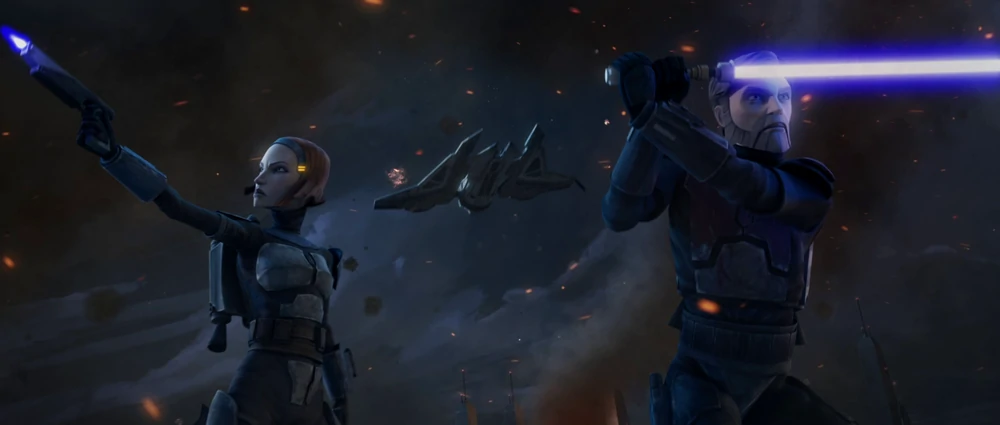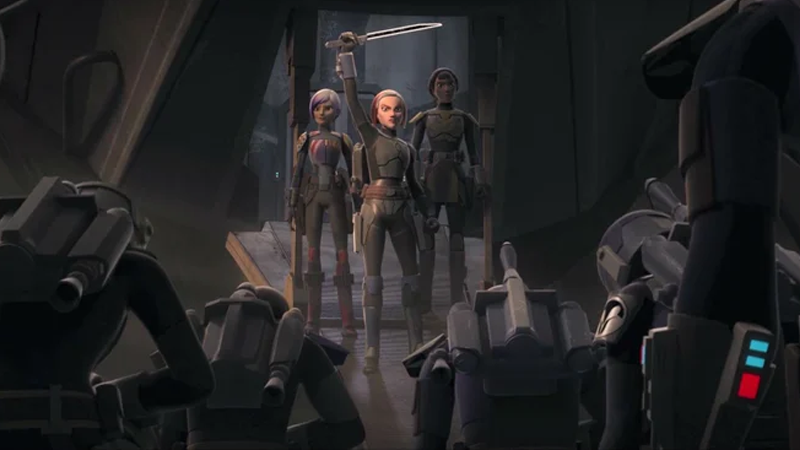The arrival of Bo-Katan Kryze on The Mandalorian is perhaps an example of Star Wars fanservice done most right by the show: without knowing who she was, Bo-Katan could easily be read by the audience as a new character, like the Armorer and Din Djarin himself. But for those who know Bo-Katan’s story, her goals in The Mandalorian set up a future for Mandalorian culture that’s been argued about for a decade.
In the third episode of The Mandalorian’s second seson, “The Heiress” — named for Bo — Din Djarin encounters the Mandalorians he’s been seeking ever since being quested to take his young ward to the Jedi. But they’re not anything like the Mandalorians he grew up alongside in his covert. Their armour is strange, they remove their helmets. They believe, somehow, that there is a future for Mandalore, a world Din only knows about from stories that tell of its cataclysmic purging. They also know of Din and his kind of Mandalorian, the children of a cult that nearly laid that homeworld low.
[referenced id=”1529424″ url=”https://gizmodo.com.au/2020/11/the-mandalorian-just-opened-up-a-galaxy-of-new-possibilities/” thumb=”https://gizmodo.com.au/wp-content/uploads/2020/11/14/ggjpjfxhzonisvio0eil-300×126.png” title=”The Mandalorian Just Opened Up a Galaxy of New Possibilities” excerpt=”In terms of pure revelations, Chapter 11 of The Mandalorian may be the show’s most significant episode yet. Short of introducing the Child in the first episode, the characters and ideas introduced this week have the potential to shake the world of Din Djarin (Pedro Pascal) to the core. They…”]
But Bo-Katan and her Nite Owls have a history far beyond The Mandalorian. In The Clone Wars, we are introduced to them as an antagonistic force in 2012’s “A Friend In Need.” Two years before that, we met her sister, Satine Kryze, in a moment that shook Star Wars fandom in some major ways. In the Star Wars canon as presented by Clone Wars — which, in the days before Disney’s acquisition of Lucasfilm, meant that thanks to George Lucas’ involvement in the production, it immediately took canon priority over sources like books and comics — Mandalorians were unlike anything fans had seen for years.

Duchess Satine was the democratically elected leader of New Mandalorians, a pacifistic reformation movement that had become popular consensus on the Mandalorian homeworld. In power, they ruled through a council of ministers, rather than through clan strength and conflict. The ways of war and codes of honour that fans had read about for years in the pages of books like the Republic Commando series (the author of which, Karen Traviss, publicly cut ties with Lucasfilm in the wake of The Clone Wars’ take on the Mandalorian culture) and comics about Boba Fett and his father before him were cast aside, replaced by peaceful non-intervention.
But those cultures were not just erased as a quasi-reboot — they still existed, and their adherents formed the Death Watch, which we know from The Mandalorian’s first season recruited orphans from the frontline of the Clone Wars like Din Djarin to its cause. A terrorist faction lead by the descendants of House Viszla, the House of the first Mandalorian Jedi that forged the Darksaber, the Death Watch believed in the old warrior ways of their people’s past. In rejection of Satine’s duchy, they also supported the king-like general and ruler that wielded the Darksaber to unite their disparate clans for thousands of years: the Mand’alor, (often written as simply Mandalore). In the wake of the Mandalorian Reformation and the rise of Kryze’s New Mandalorians, however, the Watch and its supporters were exiled from their Homeworld…Bo-Katan included, having thrown her and the Nite Owls’ lot in against her sister’s rule.

That changed when it turned out that her boss in the Death Watch, Pre Viszla, allied with Darth Maul and his growing criminal empire to stage a coup against Satine’s rule. Long story short: the Republic got involved, Maul betrayed Viszla and took control of the Death Watch, Satine was killed by the former Sith as an act of vengeance against Obi-Wan Kenobi, and generally, things kind of went to hell on Mandalore for a bit as Maul took the Darksaber and ruled a brief, chaotic reign.
Now working with the Republic after the death of her sister, B0-Katan, the Nite Owls, and the Death Watch that didn’t side with Maul’s Shadow Collective became the Mandalorian Resistance. Petitioning Ahsoka Tano and the Republic for aid, Kryze and Tano’s forces eventually subdued Maul in the Siege of Mandalore — only for the fall of the Republic and the Empire’s rise in its place to see its liberation short-lived. Now working with the aid of the Mandalorian House Saxon, the Empire subjugated Mandalore — and with the Darksaber lost to Maul’s hands, neither the peaceful New Mandalorians or the Watch of old were in much shape to form an opposition.

By the time of The Clone Wars’ animated successor Star Wars Rebels, however, the Darksaber made its way back into Mandalorian hands. After Sabine Wren secured it from Maul’s safekeeping, she was connected to the Mandalorian resistance on her homeworld by former Protector Fenn Rau — placing her into Bo-Katan’s path. Working with Kryze’s resistance and her own Clan’s forces, Sabine used the Darksaber to unite her people against the Saxon Viceroys and the Empire’s occupying forces. Mandalore was at last freed, and in handing over the Darksaber to Bo-Katan, Sabine helped establish a figurehead to rally her people behind once more.
But did she? We know that by the time of The Mandalorian, 10 years after the events of Star Wars Rebels, the Darksaber had passed hands to the sinster Moff Gideon. That Bo-Katan, as we know now, is rallying her Mandalorian allies across the galaxy in a quest to reclaim it, and rebuild her homeworld. We also know that there are Children of the Watch like Din out there, believers of the old ways of the Death Watch like Bo-Katan herself did long ago, to whom the Darksaber would represent the restoration of the old way, of the Great Mandalores of old. But Bo-Katan is also the last of House Kryze — a fact that clearly weighs on her when we meet her in The Mandalorian. She represents the last chance for her sister Satine’s vision for their people as well.

But with the Darksaber, Bo-Katan has the chance to represent both. She can claim leadership through a divine right that had previously guided Mandalorian culture for generations: a weapon symbolic of both Mandalore’s strength and its oldest traditions. And as a Kryze, as the last of her house, she also has the chance to embody the change her sister brought in with the Mandalorian reformation: peace, prosperity, a Mandalore that kept to itself but was likewise willing to help others.
Should The Mandalorian eventually pick up what it seems to be putting down — a potential path for Bo-Katan to claim the Darksaber once more, and reclaim her homeworld as its ruler — the groundwork is being laid for a Mandalorian people that re-unites the warring theses at the heart of their existence in the current Star Wars canon. And if you didn’t know who Bo-Katan was when she and her friends showed up, now you know that such a possibility could bring a fascinating end to a Star Wars subplot that’s been simmering across TV shows for years.
